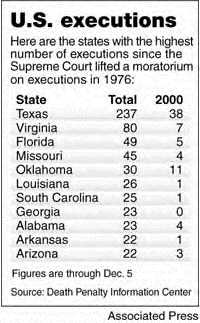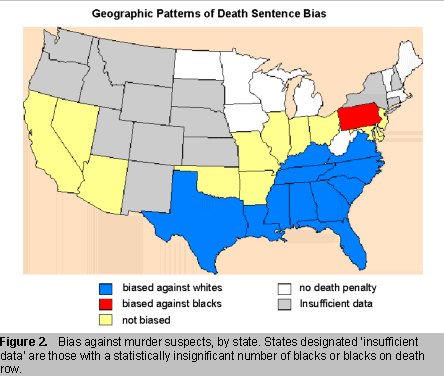|
|
 |
|
" An eye for an eye and a tooth for a tooth leaves the whole world blind and toothless."--Mahatma
Gandhi
|
 |
|

The Texas Clemency Memos-The Atlantic Magazine July/August 2003
4-29-2003 Texas County First to Call For Moratorium
4-21-2003 U.S. Supreme Court Grants Cert in Texas Death Penalty Case
U.S. Death Row Statistics
Source: NAACP Legal Defense and Education Fund, Death Row USA, Winter 2002
All figures as of Jan 1, 2002
|
Race
|
|
Percent
|
|
White
|
1,701
|
46.71%
|
|
Black
|
1,562
|
42.77%
|
|
Hispanic
|
312
|
8.54%
|
|
Native American
|
45
|
1.23%
|
|
Asian
|
32
|
0.88%
|
 Stop the Execution of the Innocent!
Oct 4, 2002
(From: ACLU website)
In recent years, numerous studies have found that one in seven people sent to death row are later proven innocent. In
the last 25 years, 102 innocent people have been released from death row.
Given this frightening history-- and with evidence mounting that more and more innocent people are sent to death row
each year--a nationwide movement has sprung up calling for a moratorium on executions. Even hard-fast supporters of the death
penalty like Republican Gov. George Ryan of Illinois have recognized that there are serious flaws in the death penalty system
that must be studied and resolved. That is why he stopped all executions in Illinois until the state can examine why more
death row inmates have been found innocent and released from prison than executed since the reinstatement of the states death
penalty in 1977.
Gov, Ryan is not the only one who sees something terribly wrong with the capital punishment system. This year, Sen. Patrick
Leahy (D-VT), a former prosecutor, and Rep. William Delahunt (D-MA), introduced the "Innocence Protection Act" (H.R.
912 and S. 486), a bill that would provide new safeguards in capital cases. 234 Representatives, and 25 Senators have cosponsored
the House and Senate Bills respectively. It is time to stop talking, pass the legeslation, and take action to end the execution
of innocent people!
States Without the Death Penalty Have Better Record on Homicide Rates
A survey by the New York Times found that states without the death penalty have lower homicide rates than states with
the death penalty. The Times reports that ten of the twelve states without the death penalty have homicide rates below the
national average, whereas half of the states with the death penalty have homicide rates above. During the last 20 tears, the
homicide rate in states with the death penalty has been 48%-101% higher than in states without the death penalty. "I think
Michigan made a wise decision 150 years ago." said the state's governor, John Engler, a Republican, referring to the state's
abolition of the death penalty in 1846. "Were pretty proud of the fact that we don't have the death penalty." (New York Times,
9/22/00)
A look at neighboring death penalty and non-death penalty states shows similar trends. Death penalty states usually have
a higher murder rate than their neighboring non-death penalty states. (See graphic below)
|
 |
|
|
|
 |
 |
 |
|

Capital Punishment and Deterrence: Examining the Effect of Executions on Murder
in Texas
Authors John Sorenson, Robert Wrinkle, Victoria Brewer, and James Marquart examined executions in Texas between 1984
and 1997. They speculated that if a deterrent effect were to exist, it would be found in Texas because of the high number
of death sentences and executions within the state. Using patterns in executions across the study period and the relatively
steady rate of murders in Tesas, the authors found no evidence of a deterrent effect. The study concluded that the number
of executions was unrelated to murder rates in general, and that the number of executions was unrelated to felony rates.(45
Crime and Delinquency 481-93, 1999)
|
|
Texas Protocol on Execution by Lethal Injection
The execution facility consists of a seperate building within the secure perimeter of the Huntsville Unit
(in Huntsville, Texas). It contains a four room suite: a room where the injection team is located, the execution chamber,
and two sight and sound-seperated witness rooms. Immediately adjacent to these rooms within the same building is a secure
housing area with ten holding cells where the prisoner is received from the Polunsky Unit (in Livingston, Texas) prior to
the execution.
After clearances have been received from the governor and the attorney general, the condemned offender is
escorted by five correctional officers from a holding cell to the execution chamber next door. He or she is then placed on
a gurney and secured by leather straps on the wrists, biceps, chest, stomach, and legs. The offender is not masked or hooded
during the execution and is allowed to turn his head to face witnesses when making a final statment.
 The injection team then sets up the IV (intravenous) tubes. Two administration sets are used, one for each arm. The line
for the right arm is held for reserve as a contingency line in case of a malfunction or blockage in the first line. A flow
of normal saline is begun.
Witnesses are then escorted into the witness room. The warden asks the offender if he has any last statement. Then the
procedure is initiated using a manual process (some states use an injection machine). First, a lethal dose of sodium
thiopental is administered which is supposed to render the offender unconscious. This takes approximatlely 30
seconds. Then pancuronium bromide, a muscle relaxant, is administered
to collapse the offender's diaphram and lungs. This takes approximately 45 seconds. Then potassium chloride is
administered to stop the offender's heart. This takes approximately 30 seconds, for a total of less than two minutes.
Several minutes after the last signs of life are evident, the warden asks the physician to be brought in to pronounce
death. The estimated average length of time that elapses from the time that the offender is restrained until the time of death
is determined is 17 minutes.
|


|
 |
|
|
|
 |
|




